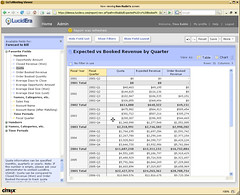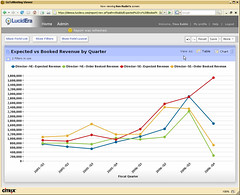“Naked blogging” is a term that’s applied to living your life transparently on the web through your blog and other social media, like Flickr, del.icio.us, Skype, LinkedIn, Library Thing and Facebook. Most of my friends around my age are appalled at the amount of information that I expose out there, although the younger crowd that I hang with at TorCamp see it as perfectly normal, and I truly believe that if you’re going to get benefit from the network effects of Web 2.0, you need to contribute every bit as much as you expect to get back.
Two weeks ago, when I had a chance for a preview of Lombardi’s new Blueprint Web 2.0-like, software-as-a-service process modeller, my first reaction was “Cool! Naked process modelling!” After all, if you could model your processes online and invite people from within or outside your organization to collaborate on the design of those processes, wouldn’t you expect to see some benefit from that collaboration?
Blueprint addresses some of the issues seen in current process modelling tools: too much complexity for the casual user, and too little ability to collaborate. They call it “process discovery” rather than process modelling, host it as software-as-a-service, and let you get started with a free version (limited to one process and two users) to try it out before you spring for the monthly subscription. Just go to the site, start sketching out your process, then invite others to participate in the design. Like a wiki, everyone who you invite to collaborate on your process can make edits, and you’ll see their edits right away — a true shared whiteboard paradigm. Last September, I used the term “process wiki” in a post and at a couple of conferences where I was speaking, and that’s pretty much what Lombardi has done here.
They’ve also integrated presence into the application using the Google Talk instant messaging client: you can see if your process collaborators are online (notice the “4 Other Users Viewing” indicator in the top right of the first screenshot below), and chat with them through Google Talk. You can also use your Google Talk buddy list to invite people to join the collaboration. As a big Skype user, I’m hoping that they add other IM clients eventually.
Given what I’ve been doing lately around Enterprise 2.0, and seeing how Web 2.0 impacts BPM, this is one of the most exciting things that I’ve seen in BPM for quite a while. I must disclose that Lombardi is a client of mine, but I’d be saying the same thing even if they weren’t.
The visual paradigm is that of outlining a process by specifying the main high-level activities, then the sub-activities within each activity. In fact, you see both the flow diagram and the outline view:

Notice anything weird about this screenshot? That’s right, it’s taken on a Mac. In fact, the Lombardi product manager who gave me the demo came into the meeting room toting his MacBook, which was not something that I was expecting to see. I’ve also seen it on Firefox on Windows. What better way to demonstrate platform independence? The Web 2.0 style interface is very slick, and there won’t be much of a learning curve for anyone who is comfortable with other web-based applications.
You can then specify a lot more detail for the process, including participants, inputs and outputs, impact analysis information such as potential failure points and likelihood of occurrence (very Six Sigma-like), and documentation.
You can also drill down into a more detailed BPMN view of the process for detailed workflow modelling:

You can generate a PowerPoint presentation from the process model, which includes all of the additional parameters specified, for presenting the business case of the process further up the management chain. The demo that I saw generated a 60-page PowerPoint presentation with every possible bit of detail; I think that the problem would be cutting it down to size rather than the usual problem of having to find information to add to the presentation.
Once the collaboration has gone as far as it can, the process model can be exported to Lombardi’s TeamWorks, using (soon-to-be-released) BPDM as the serialization format — with Lombardi’s CTO chairing the BPMI steering committee at OMG, which oversees the BPDM standards, this isn’t a big surprise. You can even round-trip the processes from TeamWorks back to Blueprint when they need another round of collaborative design.
I think that their pricing is too high — $500/month for 10 users, whereas Salesforce.com is around $165/month for a 10-user team, and is currently discounted to half of that — but that will sort itself out in the marketplace. I suggested that their free version be ad-supported, much like the freemium business models of other Web 2.0 applications like Flickr and LinkedIn; I got a few weird looks from around the table at that point, but who knows, I may have put a bug in someone’s ear.
They are almost certainly going to have requests from companies to host the application on internal servers rather than Lombardi’s software as a service, although the success of Salesforce.com (especially in maintaining privacy of data) means that there’s a lot of companies out there are that starting to trust the SaaS model. Looking in a completely different direction, I would love to see Lombardi make Blueprint open source, which would drive collaborative process modelling into places that they never imagined. Although it could negatively impact Blueprint revenue — it’s still possible to have revenue-generating open source, it just requires a bit more imagination — it could serve to drive more business to Lombardi’s core products.
In a year-end emerging trends article in December, I predicted both “modelling for the masses” and “Web 2.0 hits BPM”. Lombardi’s Blueprint delivers on both of these, and I look forward to seeing how they take it forward from here. If it’s like all other good Web 2.0 software, it will adhere to the principle of constant improvement rather than monolithic release cycles.
There’s a lot more to it than what I’ve discussed here, and if you’re interested, check out the webinar that I’m hosting tomorrow entitled Are You Ready for On-Demand BPM with Colin Teubner of Forrester Research and Jim Rudden of Lombardi, in which Jim talks a lot more about Blueprint. You can also sign up for the beta program if you want to try it out for yourself; as of the end of April, it will be available to everyone. I signed up this morning, but received the following email back from Lombardi a short while later:
Dear Sandy,
Thank you for your interest in Lombardi Blueprint. Unfortunately, due to the overwhelming number of requests for Blueprint accounts, we are unable to activate your account at this time.
We will keep your registration information in our database and will contact you when we can provide you with an account.
I’m hoping to be able to pull some strings and get in the beta program sometime soon. 🙂
For those of you who did manage to get a beta account, go on, get out there and expose your processes!





